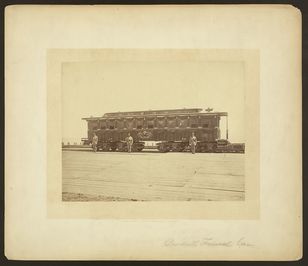|
Lincoln Funeral Train
at Marking Hoosier History
Our Lincoln Funeral Train blog is live and accepting
submissions. IHB is promoting the commemoration of the 150th anniversary of Lincoln’s
death and funeral train journey from Washington,
D.C. to Springfield, Illinois. IHB staff is blogging about the three
official Indiana stops in Richmond, Indianapolis, and Michigan City. Read
the first
post in the series about the journey and learn about not only the stops,
but how Hoosiers expressed their mourning along the route: for example, by
erecting arches of evergreen over the tracks, tolling church bells, draping
buildings in black, firing military salutes, and keeping lanterns and bonfires
lit throughout the nights.
We encourage and welcome blog posts, especially
those demonstrating/documenting reactions from around the state—using newspapers,
letters, etc., from the time. Please contact IHB if you have questions or would like to join
us in this effort -- and please encourage others to help commemorate this
very significant anniversary as well. Keep checking the IHB Lincoln
Funeral Train blog for updates on the commemorative events throughout the state
and programs at the State House in April 2015.
 Photo: President Abraham Lincoln’s Railroad Funeral Car, photograph, Library of
Congress Prints and Photographs Division Washington, D.C. 20540 USA
http://hdl.loc.gov/loc.pnp/pp.print
The Best of 2014
We’re ringing in the New Year by taking stock of our
favorite 2014 Indiana history Facebook posts, Letterman style. It’s apparent
Indiana has a lot to celebrate! If you
haven’t already, visit IHB’s
Facebook page for more inspiring, odd, and enlightening history facts.
Happy 2015!
10. On September 12, 2011, the statue "Victory"
was returned to the top of the Soldiers'
and Sailors' Monument in Indianapolis. It had been down for repairs since
April. The monument was completed in stages starting in the 1890s and dedicated
in 1902.
9. On December 23, 1867, businesswoman, entrepreneur and
philanthropist Madam C.
J. Walker was born. In Indianapolis, she established a cosmetics company on
Indiana Avenue that made her a millionaire, an exceptional accomplishment for
African American women during the time period.
8. On September 3, 1964, The Beatles, on their first wave
of popularity, appeared live at the Indiana State Fair
Coliseum and grandstand in two sold-out shows in front of 30,000 fans.
7. On December 6, 1896, Indianapolis native Marshall “Major”
Taylor won his first professional bicycle race and established himself as a
world-class cyclist. (He wired the $200 prize money to his mother!) Despite
discrimination he confronted as cycling’s earliest African American star, he
won several major championships before retiring in 1910. Learn more!
6. On June 10, 1816, the Constitutional Convention met for
the first day in Corydon. There were 43 delegates from 15 counties.
5. On April 2, 1918, the Indiana prohibition law went into
effect at midnight. Over 3,500 bars and taverns ceased the sale of alcohol. The
state ratified the national prohibition amendment the following January. Learn more about prohibition in Indiana at the State Museum.
4. On July 30, 1945, the USS
Indianapolis was torpedoed by a Japanese submarine. The ship sank in 12
minutes. Of the 1,196 crewmen aboard, approximately 300 went down with the
ship. Survivors drifted in the ocean until August 2.
3. On April 30, 1865, the funeral train for Abraham
Lincoln arrived in Indianapolis,
Indiana. His body lay in state in the rotunda of the old Capitol. An
estimated 50,000 people passed by the funeral bier.
2. On January 23, 1867, Indiana ratified the 14th Amendment,
granting citizenship to former slaves. Stephen Neal of Boone
County, Indiana is often credited for writing the original draft of the
document.
1. On December 11, 1816, President James Madison signed an
act of Congress admitting Indiana to the Union as the 19th state. Indiana was
the second state, after Ohio, to be created out of what was the Northwest
Territory. IHB has a great overview and IUPUI has a collection of primary
documents covering the Road to
Indiana Statehood.
|